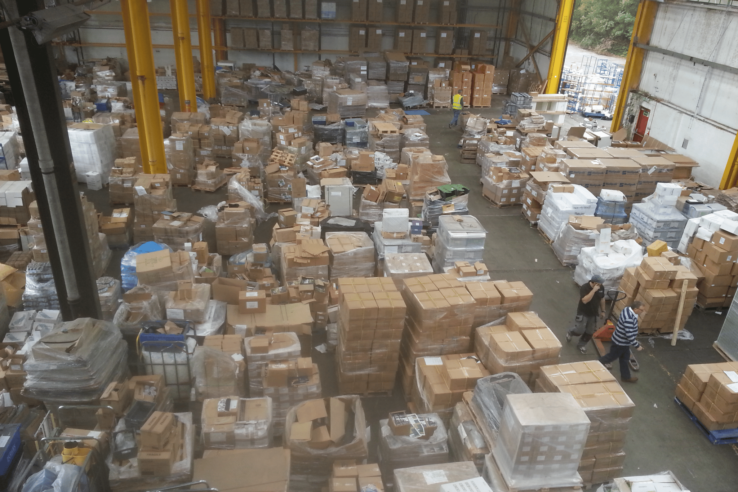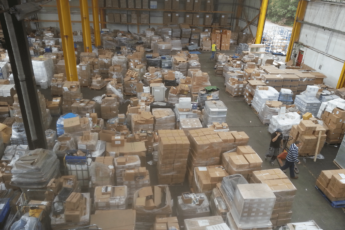1. Not using warehouse locations
If you rely on staff knowing where everything is, or having to arrange SKUs in alphabetical order to find them, you’re locked into a really inflexible approach that will severely limit the options open to you when you try to increase warehouse efficiency and productivity. Tying stock to fixed locations is an inefficient use of space and prevents any optimisation of slotting and picking processes. Introducing new products becomes disruptive and training new staff will take far longer than it should.
If SKUs are given a dedicated ‘home’ location in the warehouse every SKU has to be given enough space for the maximum quantity that will ever be present. As it’s very unlikely that all your products will be at this maximum quantity at one time there will be lots of empty space in your racking. This low stock density is not only an expensive use of space, it will also require your staff to walk greater distances than necessary, slowing down all the key warehouse operations.
Every warehouse should have a location numbering scheme that’s intuitive and completely independent of the SKUs the locations might contain. This is probably the most fundamental requirement for introducing a warehouse management system (WMS) and is a prerequisite for all the points below.
2. Still using paper
Dedicated warehouse handhelds are expensive but the benefits of introducing product barcodes and handhelds far outweighs the cost in most cases. Many operations find that majority of their SKUs are already barcoded when they arrive, but even if you need to add barcodes as part of your receipting process it’s still worth doing.
In many cases it’s not necessary to barcode individual items. Barcoding the outer carton can be a useful approach for those products that don’t already have a manufacturer barcode on each item. It’s important that your WMS is able to support multiple barcodes for the same SKU so you don’t need to relabel existing stock if barcodes change or if you want multi-source interchangeable products from different manufacturers.
Once your operation is using warehouse locations, product barcodes and handheld scanners, it will be possible to know exactly what stock you have at any given time and to know exactly where it’s being held. Perhaps more significantly, mispicks and other errors can be eliminated at source, even when new staff join your team.
3. Re-keying data or bouncing between multiple systems
Manually re-keying or cutting and pasting information is slow and error-prone and completely unnecessary. This is often done to produce courier labels or CN22 documentation, but it shouldn’t be a part of any day-to-day warehouse operation. Similarly it should be possible to complete all the key warehouse operations from within a single WMS environment.
Processes that require users to log-on to multiple platforms to generate courier labels, update the status of orders when they’ve been despatched or to adjust stock will not scale as your business grows and will allow the possibility of costly manual errors. Make sure that your WMS has a range of integration options, a public API and is able to support integration with all the external systems you need it to talk to.
4. Picking one order at a time
The most obvious way to process orders is to start with the oldest one, pick it, take it to a packing bench, pack it and repeat. Although this is the simplest way to process orders, it also requires the picker to walk far farther than necessary and repeatedly visit the same locations to pick items in ones and twos.
Unless your orders are incredibly uniform, a system that requires you to process all your orders the same way is going to be highly inefficient. It’s useful to consider your typical Monday morning orders and think about how you’d subdivide the pool to process them most efficiently. If your current WMS doesn’t allow you to do this then it’s costing you money in wasted time and missed delivery deadlines.
5. Spending too much time sorting picked items before you can pack them
Grouping orders together will increase the efficiency of your picking process. But if it’s not done carefully it can just move the bottleneck from the picker to the packer, as they’ll have to sort through a mixed tote to find the items they need.This can be reduced by limiting the number of items picked or picking into subdivided carts. This way, when a cart is presented to the packer the stock’s already sorted by the orders it’s being picked for. The aim should be to spread the workload equally between the pick and pack operations so that orders flow through both processes at roughly the same rate.
6. Not picking your best selling products or product combinations efficiently
In most environments a small proportion of the product catalog represents a significant proportion of the orders despatched every day. If these popular products or product combinations are not identified and processed separately you are missing an opportunity to make significant savings.
The 80/20 rule might apply to a few of your most popular products, it may be determined by product promotions, or it may change day-to-day as a result of factors that can’t be planned for.
So you need an order processing platform that allows you to identify the orders for your best selling products automatically and group them together.
7. Concentrating stock in just one pick face location
If you have a picking face that’s spread over more than a few aisles, and contains a large range of SKUs, it makes sense to spread the stock around. Amazon does it and there’s no reason why you shouldn’t too.
Make sure your WMS allows you to control the ‘slotting’ logic that determines where SKUs are put in the picking face. At its most basic it should ensure that each of your most popular products are spread around so your most popular SKUs are all present in every aisle of the pick face. This will dramatically increase the proportion of picks that can be completed within a single aisle and reduce the distance your pickers have to walk.
8. Accepting that training new team members has to be painful
Introducing new members of staff to your warehouse should be straightforward. In particular, having been given a fifteen minute introduction to either the picking or packing process they should be up to speed very quickly, and it should not be possible for them to make mistakes.
If your warehouse processes are complicated by lots of workarounds, exceptions and funny little rules that have built up over time it can be almost impossible for new and temporary staff to started and the whole process becomes more susceptible to errors whenever a new person is introduced. All the business rules surrounding each warehouse operation should be configured into the WMS processes that you use to support them.
9. Not knowing where the time’s going and what it’s costing you
If your users are working in a paper-based warehouse it can be hard to get an accurate picture of how much time is spent in each of your main processes. You need to know what a realistic man hour cost is for your operation and how many man hours a week are spent in each of the main warehouse processes. When you do it becomes possible to ensure the costs associated with improving your warehouse efficiency are justified.
10. Working with a WMS that can’t change and evolve
Warehouse environments are not static, your WMS needs to be able to adapt to the changing needs of your business. You should be able to introduce changes quickly and cost effectively. One aspect of this is the flexibility of the WMS platform itself but the quality of the technical support you receive is just as important. If you have to wait weeks or even months to make straightforward changes you are working with the wrong partner.
Improving your warehouse efficiency
By addressing some or all of the shortcoming described above you’ll be able to run a far more productive, efficient warehouse and despatch operation. Addressing them will usually involve some costs, however the benefits should far outweigh the original outlay.
If you tick some – or even all – of the boxes above, why not get in touch with OrderFlow to see how we can help.
Our team of multi-skilled professionals has a wealth of experience in the world of warehouse management, our OrderFlow platform provides a scalable enterprise WMS that can take your warehouse operations far beyond the fundamentals outlined above.
Why not give us a call on 01249 750564 or drop an email to enquiries@orderflow-wms.co.uk to find out more?

